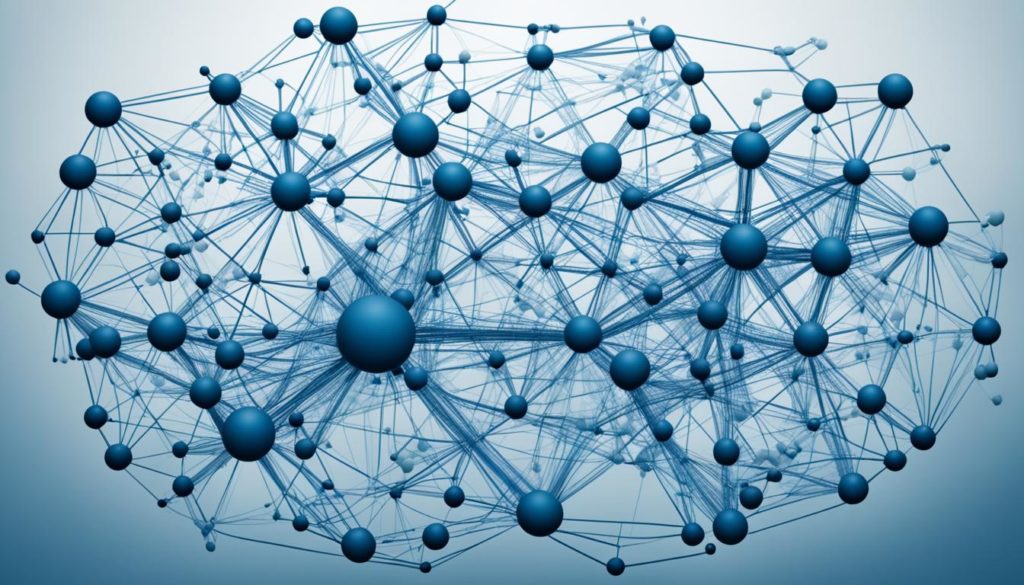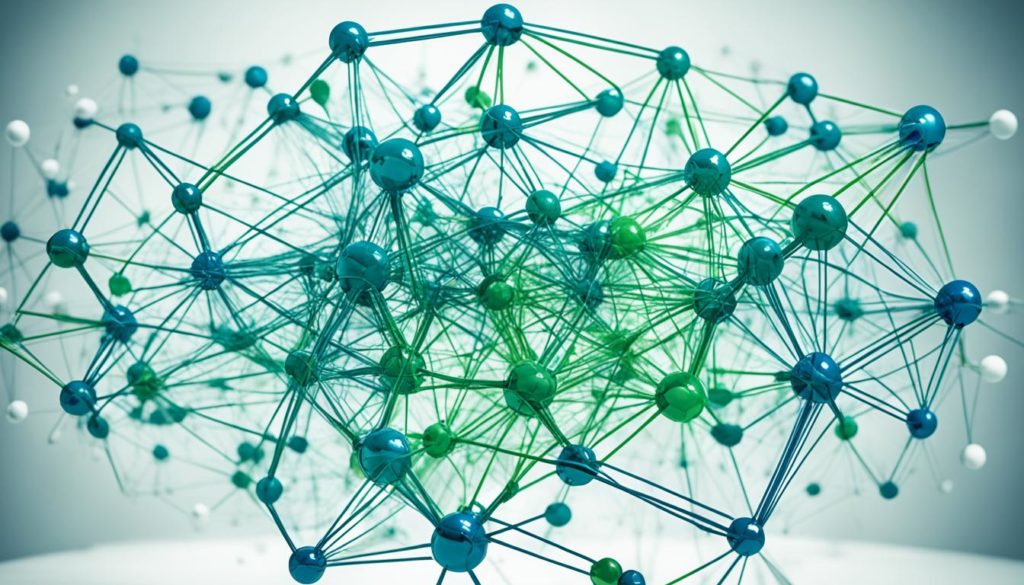
Distributed architectures let organizations grow by adding more computers as needed, with no drop in performance. This amazing ability is key to modern distributed system architecture. It’s critical for big data analytics, breaking systems into modules, and smart architecture design.
Look at Netflix and Google to see distributed systems in action. Netflix uses Amazon Web Services and a Content Delivery Network for smooth operations and growth. Google processes billions of searches daily, using clever load balancing across its network.
Understanding distributed system architecture shows why many are shifting from old, centralized networks to more adaptable, robust systems. These architectures improve scalability and offer major pluses like fault tolerance, flexibility, and better data handling.
Key Takeaways
- Distributed system architecture supports horizontal scaling, enhancing performance.
- Data replication in distributed systems ensures high availability and operational continuity.
- Load balancing optimizes resource utilization by evenly distributing tasks.
- Companies like Netflix and Google exemplify effective uses of distributed architectures.
- Transitioning from monolithic to modular systems enhances fault tolerance and scalability.
Basics of Distributed Systems
Distributed systems are like teams of computers working together. These systems let multiple computers share tasks and data across a network. Unlike a single computer doing all the work, distributed systems spread it out. This makes sure everything runs smoothly and together.
What is a Distributed System?
A distributed system connects different computers to work as one. Even though they are separate, they act together for the user. They handle tasks at the same time, making things faster than on a single computer.
Key Components of Distributed Systems
The parts that make up distributed systems include:
- Primary System Controller: This part keeps an eye on server requests and manages them.
- Secondary Controller: It helps by organizing server requests and translations.
- User-Interface Client: This allows users to interact and control the system easily.
- System Datastore and Relational Databases: They share data and let many users access it at the same time.
Why Use Distributed Computing Systems?
Distributed computing systems have a lot of benefits:
- Scalability: You can add more computers as needed, which you can’t do as easily with just one computer system.
- Redundancy and Fault Tolerance: If one computer fails, the others keep the system running without interruption.
- Load Balancing: Tasks are spread out evenly, which makes everything more efficient and prevents any one computer from getting too overloaded.
- Enhanced Operational Efficiency: Businesses in various fields use these systems for better performance and service.
| Feature | Distributed Systems | Centralized Network |
|---|---|---|
| Scalability | High | Limited |
| Fault Tolerance | Robust | Vulnerable |
| Load Balancing | Efficient | Inefficient |
Advantages and Challenges of Distributed System Architecture
Distributed system architectures boost scalability and reliability for businesses. They face unique challenges too, which need solutions for top performance.
Scalability
Scalability is a key benefit of distributed computing. Businesses can add more nodes for handling bigger workloads. This helps growing companies satisfy increasing user demands effectively.
Fault Tolerance
Fault tolerance is another advantage. These systems keep running even if a node fails. Redundancy is important here, ensuring the system stays reliable by duplicating critical parts.
Load Balancing
Load balancing is crucial for effective management. It spreads out workloads evenly across servers. This stops any node from getting too stressed, optimizing performance and hardware lifespan.
Network Latency and Security Concerns
However, distributed systems face issues like network latency and security. These can impact performance and involve major security risks. Effective coordination and strong security are vital for secure and efficient operations.
| Aspect | Advantages | Challenges |
|---|---|---|
| Scalability | Enables horizontal scaling | Requires careful planning |
| Fault Tolerance | Maintains operation amidst node failures | Involves complex fault-tolerant design and redundancy measures |
| Load Balancing | Distributes server load evenly | Demands precise load balancing strategies |
| Network Latency and Security | Enhances data distribution flexibility | Results in potential performance bottlenecks and security vulnerabilities |
Key Concepts in Distributed Architecture
Understanding nodes and clusters is key in distributed architecture. Nodes are single units that add to the total computing power. Clusters are groups of these nodes that work together. This teamwork boosts system performance and durability.
Data replication and sharding help manage and share data better. Data replication copies data across many nodes for reliability and availability. Meanwhile, sharding divides big databases into smaller, easier-to-handle pieces. This split improves performance and growth.
Having failover strategies is crucial for keeping systems up and reliable. These strategies help the system deal with failures. They move tasks from broken parts to ones that work, keeping services going.
Effective load balancing is vital in distributed computing frameworks. It spreads out requests across several servers. This balance makes better use of resources and increases efficiency, especially when there are lots of requests.
Putting these elements together forms a strong base. This foundation lets distributed systems work well under changing loads. It helps them meet today’s need for high-performance computing.
Advanced Topics in Distributed Architecture
Exploring advanced topics in distributed architecture is key to grasping the complexity of these systems. They show us how large applications stay strong, fast, and flexible. We get to understand the important ideas behind these designs.
CAP Theorem
The CAP principle is a key rule in designing distributed systems. It tells us a system can’t have consistency, availability, and partition tolerance all at once. For example, if consistency and availability are most important, partition tolerance must be less of a priority. Knowing this helps developers choose what to focus on, depending on their needs.
Service-Oriented Architecture (SOA)
Service-oriented architecture is about making systems that are easy to change and work well with others. It’s how big tech companies keep their systems flexible and current. This approach allows service updates without big problems, boosting system efficiency.
Distributed Databases
Distributed databases are crucial for accessing data fast from different places. They can handle a lot of work without slowing down. For example, using technology like Google’s Spanner, these databases stay available and reliable, even with network issues.
Real-World Case Studies
Real examples show how strong distributed architecture can benefit companies. Netflix uses many small services to stream videos to millions of people every day. They can scale up quickly and update with no downtime. Similarly, Google’s search engine uses clever tricks to deal with billions of searches, keeping it fast. These cases help us see how theories apply in real situations.
These advanced topics uncover the many layers of distributed architecture. From basics like the CAP theorem to more advanced stuff like service-oriented designs and databases, each idea helps manage sprawling, intricate systems.
Conclusion
Distributed system architecture is key for high availability and scalability in heavy-data apps. It helps handle huge data volumes while keeping downtime low and managing faults well. The shift from single, large systems to modular designs has led to better and more adaptable solutions.
By using distributed architectures, we avoid bottlenecks and single points of failure. This is vital for systems that need to be both fast and reliable. With tools like microservices, applications are split into services. This improves redundancy and fault isolation. Technologies like Kubernetes help in managing resources better, letting businesses grow easily.
Still, distributed systems face issues like network delays, security risks, and complex upkeep. But, constant monitoring and tweaking can help tackle these problems. Innovations in grid computing and microservices push the limits of distributed systems. This puts them at the edge of innovation, ensuring a strong future for ventures with intensive data needs.
FAQ
What is a Distributed System?
A distributed system is a set up of different computers that work together. They are managed by software that oversees resource sharing and tasks. This setup is great for handling large amounts of data efficiently.
What are the key components of Distributed Systems?
Key parts include a main controller, a backup controller, a user interface, system storage, and databases. They help manage requests, interact with users, and allow many users to access data at the same time.
Why use Distributed Computing Systems?
They offer benefits like being able to grow easily, not failing completely if something goes wrong, and balancing loads. They improve work efficiency and are great for many industries like finance and healthcare.
What is Scalability in Distributed Systems?
Scalability means a system can grow to handle more work by adding new computers. It’s done through horizontal scaling, which means adding more servers.
How do Distributed Systems achieve Fault Tolerance?
They use extra parts and backup plans. These make sure the system stays up, even if something fails.
What is Load Balancing in Distributed Systems?
It’s about spreading out work so no single computer gets too busy. This makes the system use resources better and stay efficient.
What challenges do Distributed Systems face regarding Network Latency and Security?
The main issues are delays in communication and security risks. Fixing these issues means getting the balance right as the system grows larger.
What roles do Nodes and Clusters play in Distributed Architecture?
Nodes and clusters increase the system’s power and reliability. They are crucial for effective operation, improving performance, and keeping the system available.
What is Data Replication and Sharding in Distributed Systems?
Data replication makes copies of data across computers for better uptime and safety. Sharding splits the database to improve speed and size handling.
What is the CAP Theorem?
It’s about understanding the balance between Consistency, Availability, and Partition Tolerance. It guides the structure of systems by focusing on these important elements.
What is Service-Oriented Architecture (SOA)?
SOA allows different services to work together easily. It’s good for creating systems that can grow and change over time.
What are Distributed Databases?
These databases spread data across many places. This lets people access data quickly, no matter where they are.
Can you provide Real-World Case Studies of Distributed Systems?
Netflix and Google show how effective these systems are. Netflix delivers content well because of its flexible structure. Google manages its huge amount of web traffic with advanced load balancing.
Future App Studios is an award-winning software development & outsourcing company. Our team of experts is ready to craft the solution your company needs.










